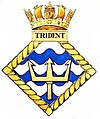HMS Trident (N52)

HMS Trident
|
|
| History | |
|---|---|
|
|
|
| Name: | HMS Trident |
| Builder: | Cammell Laird & Co Limited, Birkenhead |
| Laid down: | 12 January 1937 |
| Launched: | 7 December 1938 |
| Commissioned: | 1 October 1939 |
| Fate: | Sold to be broken up for scrap 17 February 1946 |
| Badge: | |
| General characteristics | |
| Class and type: | British T class submarine |
| Displacement: |
|
| Length: | 275 ft (84 m) |
| Beam: | 26 ft 6 in (8.08 m) |
| Draught: |
|
| Propulsion: |
|
| Speed: |
|
| Range: | 4,500 nautical miles at 11 knots (8,330 km at 20 km/h) surfaced |
| Test depth: | 300 ft (91 m) max |
| Complement: | 59 |
| Armament: |
|
HMS Trident was a British T class submarine built by Cammell Laird, Birkenhead. She was laid down on 12 January 1937 and was commissioned on 1 October 1939. HMS Trident was part of the first group of T class submarines.
Trident operated in most of the naval theatres of the Second World War, in home waters in the North Sea and off the Scandinavian coast, in the Mediterranean and in the Pacific far east.
Trident spent the period from 1941 to mid 1943 in the North Sea, where she sank the German merchants Edmund Hugo Stinnes 4, Ostpreußen, Donau II, Hödur and Bahia Laura, the German tanker Stedingen and the German auxiliary submarine chaser UJ 1213 / Rau IV. She also attacked and damaged the German merchants Cläre Hugo Stinnes and Levante, and unsuccessfully attacked the German merchants Palime, Wandsbek, Pelikan and Altkirch, the German oiler Dithmarschen, the German hospital ship Birka, the German minesweeper depot ship MRS 3 / Bali and the German submarine U-31. Whilst returning to base at Polyarnoe, Russia, Trident was fired upon but missed by the German submarine U-566
Perhaps her most important targets were the German cruiser Prinz Eugen and Admiral Scheer, which she sighted off Norway on the 23 February 1942. Trident fired seven torpedoes against them, one of which hit Prinz Eugen in the stern and jammed her rudder and damaged her engines, but the Admiral Scheer escaped unscathed.
During much of this time the submarine had a young reindeer doe on board. It had been presented as a gift by the Russians in August 1941 as part of the diplomatic ceremonies to honour the alliance between Russia and Britain. The Reindeer was named Pollyanna after the base and apparently adapted well to life on board. When the submarine returned to the UK Pollyanna had grown to the extent that the services of the local slaughterman had to be used to truss her securely so she could be safely removed from the boat. Pollyanna then proceeded to live out the rest of her days in the local zoo.
...
Wikipedia

